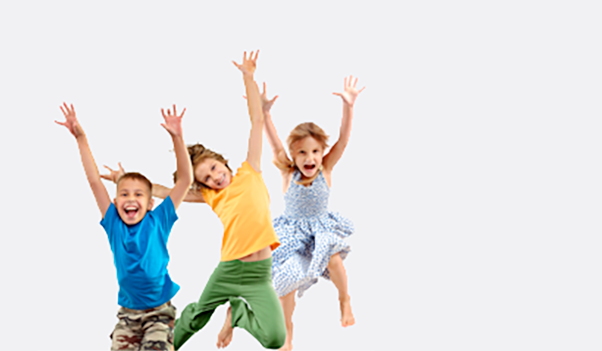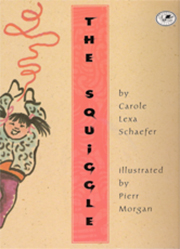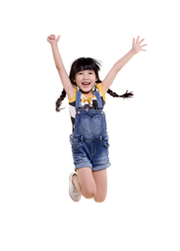SUBJECTS
GRADE
Show Results
The Squiggle

Lesson Summary
- Identify the beginning, middle, and end of a story.
- Explore a movement inspired by The Squiggle by Carole Lexa Schaefer.
Lesson Plan and Procedure
Lesson Key Facts
- Grade(s): K, 1
- Subject(s): Dance, English Language Arts
- Duration of lesson: 30-40 minutes
- Author(s): Jana Shumway
Experience/Identify
Read The Squiggle by Carole Lexa Schaefer.

After reading the book, look around the room and notice one “squiggle” line (ribbon) lying in a corner. Have one of the children bring it over to you. Comment that you wish all the children could have a squiggle. Then retrieve ribbons from a hiding place and give ribbons to all the children.
Explore/Investigate
Go through the main parts of the story with movement and ribbons.
Activity 1: Dragon
Show images of a Chinese dragon.
Play the song "Said the Emperor" by Richard Souther.
Use a drum and invite the children to put their ribbons in the air and paint a dragon’s face.
Teacher: Paint the spikes down his back. Draw a long tail. Shoot fire from its mouth. Wag the ribbon like a tail behind you. Paint jagged teeth.
Activity 2: Great Wall
Show images of the Great Wall of China.
Play the song “Sunshower” by Friedmann.
Have the children lay their ribbons on the floor to create the Great Wall of China.
Look at the images of the Great Wall of China and talk about how it's like a ribbon—or a squiggle.
Have the students jump and gallop over their personal ribbon for several minutes, then have students look around the room for other items that look like "Great Walls." Have them jump over as many as they can, then come back to their ribbon and make a "Great Wall" shape next to it.

Activity 3: Acrobat
Show images of different acrobatic shapes.
Play the song “Kalandero” by Cirque Du Soleil.
Have the children lay the "squiggle" line on the floor in a straight line and walk across it as if it were a tight rope. Then have students experiment with different movements, such as hop on one leg, jump sideways, create balancing shapes, tiptoe, leap, and so on.
Activity 4: Fireworks
Show images of fireworks.
Play the song “Change of the Gods" by Tangerine Dream.
Have the children pretend to shoot fireworks into the sky while holding and using their ribbons. Have the children hold a shape and, on the count of three, do an explosive jump whipping out their ribbon.
Have the children move their ribbons in a squiggle pathway for four counts, then jump for three counts: Jump, jump, jump, explode!
Activity 5: Storm Cloud
Show images of various clouds.
Play the song “Clouds” by Public Dream.
Have the children hold both ends of the “squiggle” and sway it back and forth above their heads. Have them make their ribbon travel through the sky like a cloud.
Have the students spin with their ribbons and move their ribbons low and high in the sky like clouds.

Activity 6: Pool
Show images of rain puddles.
Play the song “After the Rain” by Michael Jones.
Have the children lay their "squiggle" on the floor in a circle (puddle or pool). Have the children run around the pool, hop in and out of it, spin inside of it, push their hands around the edges, and swim inside their pool.
Have the children notice the other pools in the room and splash and play in them.
Activity 7: Moon
Show images of the moon.
Play the song “Valley in the Clouds” by David Arkenstone.
Have the children hold both ends of the ribbon as if it were the moon. Have them leap and jump, trying to get the moon higher and higher in the air. See who can jump the highest.
Create/Perform
Have half of the class sit while the other half of the class shows them all the things they can do with their "squiggle." If you as the teacher notice something especially interesting, call it out and have the whole class stand up and try it. Switch sides. Repeat.
Connect/Analyze
Have students identify the beginning, middle, and end of their ribbons.
Have the children recall the beginning, middle, and end of the story The Squiggle.
Show pictures from the book for each of the different sections.
Learning Objectives
- Retell information from a text.
- Recall key details from a text.
- Respond with movement to improvisational cues.
- Perform for others.
Utah State Board of Education Standards
This lesson can be used to meet standards in many grades and subject areas. We will highlight one grade’s standards to give an example of application.
Grade K Language Arts
Standard K.R.5: With prompting and support, ask and answer questions about key details in text. (RL & RI)
Grade K Dance
Standard K.D.CR.4: Respond to suggestions and change movement through guided improvisational experiences.
Standard K.D.P.7: Dance for and with others using established performance etiquette.
Equipment and Materials Needed
- Schaefer, Carlole Lexa. The Squiggle. New York: Crown Publishers, 1999.
- Drum
- Ribbons for each child
- Musical tracks:
- “Said the Emperor” by Richard Souther
- “Sunshower” by Friedmann
- “Kalandero” by Cirque Du Soleil
- “Change of the Gods” by Tangerine Dream
- “Clouds” by Public Dream
- “After the Rain” by Michael Jones
- “Valley in the Clouds” by David Arkenstone
- Images of the following:
- Dragon
- Great Wall of China
- Acrobatic moves
- Fireworks
- Different kinds of clouds
- Rain puddles/pools
- Moon
Additional Resources
There are several examples online of teaching materials using this book, in which students connect to visual arts by drawing new images using a "squiggle" line.
- https://www.youtube.com/watch?v=y58vETNlt9I
- https://tinkergarten.com/activities/a-twist-on-the-squiggle
https://www.teachervision.com/classroom-management/squiggle-drawing
Students can also extend their learning by writing a sentence or descriptive paragraph about their drawings.
Image References
Image 1: Shutterstock (https://thumb1.shutterstock.com/display_pic_with_logo/344920/520268437/stock-photo-group-of-happy-cheerful-sportive-barefoot-children-kids-jumping-and-dancing-kids-group-portrait-520268437.jpg).
Image 2: The Squiggle, by Carole Lexa Schaefer (https://www.amazon.com/Squiggle-Carole-Lexa-Schaefer/dp/0517885794/ref=sr_1_1).
Image 3: Shutterstock (https://www.shutterstock.com/image-photo/active-joyful-boy-jumping-joy-over-144153277?src=1g9gp7F2LZLdCKD-juEfzw-1-23).
Image 4: Shutterstock (https://www.shutterstock.com/image-photo/portrait-happy-little-asian-child-jumping-264652643?src=6D0bTrOaDp0aDca0vi5QTg-1-9).

www.education.byu.edu/arts/lessons
 Download
Download